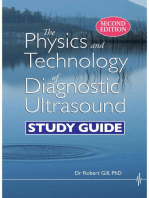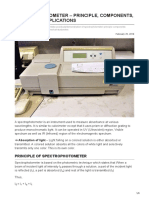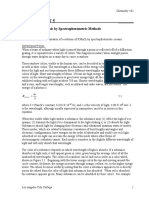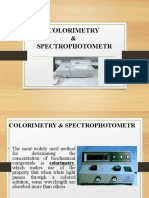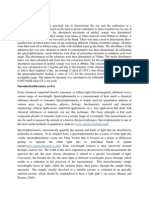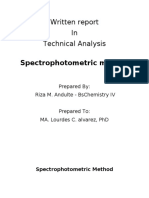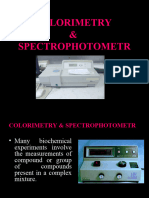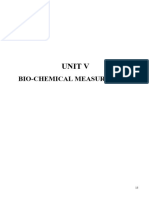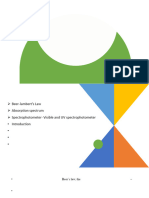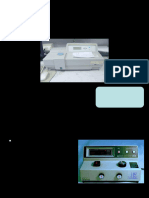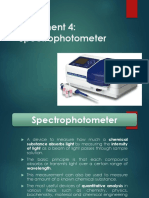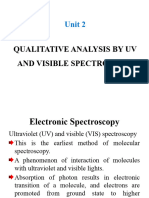11 Chapter 11
11 Chapter 11
Uploaded by
Smita SahooCopyright:
Available Formats
11 Chapter 11
11 Chapter 11
Uploaded by
Smita SahooOriginal Description:
Copyright
Available Formats
Share this document
Did you find this document useful?
Is this content inappropriate?
Copyright:
Available Formats
11 Chapter 11
11 Chapter 11
Uploaded by
Smita SahooCopyright:
Available Formats
Chapter 11 Spectrophotometer meter
1. Introduction
Absorption Spectroscopic methods of analysis rank among the most widespread and powerful tools for quantitative analysis. The use of a spectrophotometer to determine the extent of absorption of various wavelengths of visible light by a given solution is commonly known as colorimetry. This method is used to determine concentrations of various chemicals which can give colours either directly or after addition of some other chemicals. As an example, in the analysis of phosphate, a reaction with orthophosphate is made, to form the highly coloured molybdenum blue compound. The light absorption of this compound can then be measured in a spectrophotometer. Some compounds absorb light in other than the visible range of the spectrum. For example, nitrates absorb radiation of 220 nm wave length in the UV region.
2. Theory
Absorption Spectroscopic methods of analysis are based upon the fact that compounds ABSORB light radiation of a specific wavelength. In the analysis, the amount of light radiation absorbed by a sample is measured. The light absorption is directly related to the concentration of the coloured compound in the sample. The wavelength () of Maximum Absorption is known for different compounds. For example, the coloured compound formed for analysis of Phosphate (molybdenum blue) has maximum light absorption at = 640 nm. Conversely, a minimum amount of light is transmitted through the compound at = 640 nm. This is shown schematically in Figure .1
Figure 1: Light Absorption and Transmission by Phosphate-molybdenum blue compound. Schematic diagram showing maximum light absorption (and minimum light transmission) at = 640 nm.
65
The Beer-Lambert Law The Beer-Lambert Law is illustrated in Figure 2. The Absorbance (or optical density) and Transmission (or Transmittance) of light through a sample can be calculated by measuring light intensity entering and exiting the sample, L C ... Figure 2: Light energy of Intensity 'I0' passes through a sample with concentration 'C'. Some light energy is absorbed by the sample. The amount of light energy exiting the sample has Intensity 'I' The following terms are defined: Light Intensity entering a sample is "I0 " Light Intensity exiting a sample is "I" The concentration of analyte in sample is "C" The length of the light path in glass sample cuvette is "L" . "K" is a constant for a particular solution and wave length The Beer-Lambert Law is given by the following equations: Light Absorbance (A) = log (I0 / I)= KCL Light Transmission (T) = I/I0 = 10-KCL Plots of absorbance and transmission versus concentration of the analyte in sample according to the above equations is shown in Figure 3,
Concentration
Concentration
Figure 3: Beer-Lambert Law relates the amount of light Absorbance (A) by a solution to the Concentration (C) of a compound in solution and the length of light path: As Concentration (C) increases, light Absorption (A) increases, linearly . As Concentration (C) increases, light Transmission (T) decreases, exponentially
66
3.
The Spectrophotometer Instrument
All spectrophotometer instruments designed to measure the absorption of radiant energy have the basic components as follows (Figure 4): 1. a stable source of radiant energy (Light); 2. a wavelength selector to isolate a desired wavelength from the source (filter or monochromator); 3. transparent container (cuvette) for the sample and the blank; 4. a radiation detector (phototube) to convert the radiant energy received to a measurable signal; and a readout device that displays the signal from the detector. Light Source
Monochromator
Sample Phototube Measuring Absorbed / Transmitted
Figure 4: Components of a spectrophotometer The energy source is to provide a stable source of light radiation, whereas the wavelength selector permits separation of radiation of the desired wavelength from other radiation. Light radiation passes through a glass container with sample. The detector measures the energy after it has passed through the sample. The readout device calculates the amount of light absorbed by the sample displays the signal from the detector as absorbance or transmission. The spectrophotometers which are used for such measurements may vary from simple and relatively inexpensive colorimeters to highly sophisticated and expensive instruments that automatically scan the ability of a solution to absorb radiation over a wide range of wavelengths and record the results of these measurements. One instrument cannot be used to measure absorbance at all wavelengths because a given energy source and energy detector is suitable for use over only a limited range of wavelengths. True linearity between absorbance and concentration according to Beer-Lambert Law requires the use of monochromatic light. In addition, a narrow band of light ensures a greater selectivity since substance with absorption peaks in other close by wavelengths are less likely to interfere. Further, it increases sensitivity as there is a greatest change in absorbance per increment of change in concentration. Both filters and monochromators are used to restrict the radiation wavelength. Photometers make use of filters, which function by absorbing large protions of the 67
spectrum while transmitting relatively limited wavelength regions. Spectrophotometers are instruments equipped with monochromators that permit the continuous variation and selection of waveiength. The effective bandwidth of a monochromator that is satisfactory for most applications is about from 1 to 5 nm. The sample containers, cells or cuvettes, must be fabricated from material that is transparent to radiation in the spectral region of interest. The commonly used materials for different wave length regions are: Quartz or fused silica: Silicate glass: Plastic: Polished NaCI or AgCI: UV to 2 m in I R Above 350 nm to 2 m in I R visible region Wave lengths longer than 2 m
Cuvettes or cells are provided in pairs that have been carefully matched to make possible the transmission through the solvent and the sample. Accurate spectrophotometric analysis requires the use of good quality, matched cells. These should be regularly checked against one another to detect differences that can arise from scratches, etching and wear. The most common cell path for UV-visible region is 1 cm. For reasons of economy, cylindrical cells are frequently used. Care must be taken to duplicate the position of such cells with respect to the light path; otherwise, variations in path length and in reflection losses will introduce errors.
4. General Measurement Procedures
As explained above, the Beer-Lambert Law forms the basis of the measurement procedure. The amount of light radiation absorbed by a compound is directly related to the concentration of the compound. The general measurement procedure consists of 5 steps: 1. Prepare samples to make coloured compound 2. Make series of standard solutions of known concentrations and treat them in the same manner as the sample for making coloured compounds 3. Set spectrophotometer to of maximum light absorption 4. Measure light absorbance of standards 5. Plot standard curve: Absorbance vs. Concentration, as shown in Figure 5 Once the standard plot is made, it is simple to find the concentration of an unknown sample: Measure the absorption of the unknown, and from the standard plot, read the related concentration (Figure 6).
68
Figure 5:
Concentration Plot of the standard curve: showing the linear relation between light absorption and concentration of the standards
Figure 6: Finding the concentration of an unknown sample from the standard curve. Due to the fact that the overall composition of the sample is seldom the same as that of the calibration standard, in some cases, the absorption characteristics of the two may differ. Where such discrepancy is suspected, the standard addition approach may be used, Here, a known amount of analyte is added to a second aliquot of the sample. The difference in absorbance is used to calculate the analyte concentration of the sample as illustrated in Example 1.
Absorbance
69
Example 1 A 25 mL sample after treatment with reagents to generate colour for measurement of phosphate yielded absorbance of 0.428. Addition of 1.00 mL of a solution containing 5.0 g phosphorus to a second 25 mL aliquot and development of colour resulted in an absorbance of 0.517. Calculate g phosphorus in each mL of sample. Solution: Correct absorbance for dilution: Corrected absorbance = 0.517 (26.0/25.0) = 0.538 Absorbance caused by 5 g phosphorus = 0.538 - 0.428 = 0.110 Therefore, phosphorus in the sample = (5.0/0.11) 0.428 = 19.5g, or 19.5/25 = 0.8g/mL
70
OPERATING INSTRUCTIONS FOR SPECTROPHOTOMETER
1. Ensure 230V, 50Hz, single-phase power supply is available in the 3 contact 5A power point. 2. Insert the power cord of the instrument in to a power point. 3. Turn the switch at ON position. 4. Warm up the instrument for 15 minutes. 5. Press %T selector switch. 6. Adjust wavelength control to read the wavelength at which the test is desired. 7. Open the sliding lid of the sample compartment. 8. Turn the filter sliding control at filter position-1 to set zero adjustment, 9. Close the sliding lid of the sample compartment. 10. Turn the coarse and fine controls at their maximum and adjust %T control to get 0.00 displayed on the read out with the filter position-1. 11. Now turn the filter sliding control at required position decided based on the wavelength selected. Filter Position 2 3 4 Wavelength Below 395 nm 395 to 600 nm Above 600nm
12. Keep the blank cuvette at position-1. 13. Keep the sample cuvette at position 2. 14. Adjust 100%T (%T selector switch should be in pressed position) or 0.0 absorbance (O.D selector switch should be in pressed position) using coarse and fine controls knob with blank cuvette. 15. Pull the cuvette position control at position-2. 16. Read out the transmittance/absorbance of the sample.
71
CHECKING THE PERFORMANCE OF THE SPECTROPHOTOMETER
1. Preparation of Blank:Measure accurately 10 ml of Anal R quality HCl of 36-46% concentration. Add it slowly to 400 ml distilled water filled in one litre volumetric flask. Make it up to mark with distilled water and mix it up well. 2. Preparation of sample Weigh exactly 22.2 gm of Anal R quality Cobalt Chloride(COCl2 ).Transfer into one litre volumetric flask. Dissolve it in 1% Hydrochloric Acid (HCl) and make it up to the mark. 3. Fill the blank (1%HCl) & sample (COCl2 Solution) solution in cuvettes. 4. Perform the steps same as given operating instructions to measure the Transmittance/absorbance at wavelength 480 to 540 nm at 5nm interval. 5. Plot the graph of absorbance versus wavelength. Graph should be in increasing order up to 510-515nm wavelength and then in decreasing order Precautions 1. Always clean the cells thoroughly and rinse at least once with a portion of the sample, before filling the sample for measurement. 2. Always wipe the exposed surface of the cells dry and free from finger prints, using tissue paper. 3. Clean cells thoroughly immediately after use and prior to use. 4. Do not leave solutions, particularly strong alkali, in the cells for periods more than an hour. 5. Ensure no air bubbles the inner surfaces of the cells. 6. Never use a brush or any tool for cleaning which may scratch the optical surfaces. Cleaning Method Take 1gm of Potassium dichromate, add a little distilled water and very slowly add approximately 100ml of Conc.H2SO4. Keep the cells in this acidic solution for a maximum period of 12hrs. Wash the cells thoroughly with distilled water before use.
72
You might also like
- Reflectance SpectrophotometryDocument3 pagesReflectance SpectrophotometryMarkiel IndonNo ratings yet
- Experiment 2 Uv-Visible Determination of An Unknown Concentration of Kmno Solution Theory/BackgroundDocument13 pagesExperiment 2 Uv-Visible Determination of An Unknown Concentration of Kmno Solution Theory/BackgroundMuhammad Azri HaziqNo ratings yet
- The Physics and Technology of Diagnostic Ultrasound: Study Guide (Second Edition)From EverandThe Physics and Technology of Diagnostic Ultrasound: Study Guide (Second Edition)No ratings yet
- Calorimeter and Spectrophotometer NotesDocument13 pagesCalorimeter and Spectrophotometer Notesbalozirobert254No ratings yet
- Final LabDocument202 pagesFinal Labshahedalamour3No ratings yet
- Lab #4 SpectrophotometryDocument10 pagesLab #4 Spectrophotometrythamizh555No ratings yet
- Lab Week 2 - Spectrophotometry: Basic Laws of Light Absorption. For A Uniform Absorbing Medium (Solution: Solvent andDocument7 pagesLab Week 2 - Spectrophotometry: Basic Laws of Light Absorption. For A Uniform Absorbing Medium (Solution: Solvent andfrhslmnNo ratings yet
- Detecting and Quantifying Biological Molecules Using SpectrophotometryDocument12 pagesDetecting and Quantifying Biological Molecules Using SpectrophotometryAGNo ratings yet
- Spectrophotometry04 1Document9 pagesSpectrophotometry04 1prakush_prakushNo ratings yet
- UV-Vis LabDocument5 pagesUV-Vis LabCesar GutierrezNo ratings yet
- Individual Report FormatDocument5 pagesIndividual Report FormatHarley Ned AquinoNo ratings yet
- BCH 315 First Lecture NoteDocument12 pagesBCH 315 First Lecture Notemichaelokuchukwu22No ratings yet
- Spectrophotometer Principle Components Working ApplicationsDocument6 pagesSpectrophotometer Principle Components Working ApplicationsAhmed IsmailNo ratings yet
- Ei 6501 Analytical Instruments Unit-I Colorimetry and SpectrophotometryDocument24 pagesEi 6501 Analytical Instruments Unit-I Colorimetry and SpectrophotometryBarani DharanNo ratings yet
- Equipments 2Document24 pagesEquipments 2Khushi KumariNo ratings yet
- Experiment 5 - : Quantitative Analysis by Spectrophotometric MethodsDocument7 pagesExperiment 5 - : Quantitative Analysis by Spectrophotometric MethodsBryanNo ratings yet
- COLORIMETRYDocument29 pagesCOLORIMETRYaqsa imranNo ratings yet
- SpectrophotometerDocument4 pagesSpectrophotometersoroutaditya04No ratings yet
- Use and Calibration of SpectrophotometerDocument11 pagesUse and Calibration of SpectrophotometerTinashe W Mangwanda100% (1)
- L10Document5 pagesL10anaNo ratings yet
- Uv Vis SpectrophotometerDocument7 pagesUv Vis SpectrophotometerFath Bond100% (1)
- Polymer Analysis by UVDocument10 pagesPolymer Analysis by UVnethumini GunawardanaNo ratings yet
- Lambert Beers LawDocument9 pagesLambert Beers Lawblah63621No ratings yet
- Lecture Notes UV - Vis and Colorimetry 2023 - 24 SessionDocument6 pagesLecture Notes UV - Vis and Colorimetry 2023 - 24 Sessionvicktoresi129No ratings yet
- Spectrophotometry 0Document27 pagesSpectrophotometry 0ilesanmioluwagbohunmi02No ratings yet
- Chem 137.1 - Exer 1 PostlabDocument15 pagesChem 137.1 - Exer 1 PostlabGerry Mark Gubantes100% (1)
- Practical Clinical BiochemistryDocument24 pagesPractical Clinical BiochemistryHelal HamadNo ratings yet
- Spectrophotometer: - Class: 1ADocument12 pagesSpectrophotometer: - Class: 1Aniken larasatiNo ratings yet
- COLORIMETRYDocument8 pagesCOLORIMETRYbehappykoo1997No ratings yet
- Report Ni RizaDocument8 pagesReport Ni RizaInga Budadoy NaudadongNo ratings yet
- COLORIMETRYDocument30 pagesCOLORIMETRYSusovon ChowdhuryNo ratings yet
- SPECTROPHOTOMETRYDocument3 pagesSPECTROPHOTOMETRYMelkamu ZazaNo ratings yet
- UV VIS Spectroscopy and SpectrophotometryDocument18 pagesUV VIS Spectroscopy and Spectrophotometrymajdkhashan999No ratings yet
- Colorimetry & SpectrophotometrDocument30 pagesColorimetry & SpectrophotometrBadruzzaman BarbhuiyaNo ratings yet
- EXPERIMENT 1 chm260Document10 pagesEXPERIMENT 1 chm260Muhammad Azri HaziqNo ratings yet
- Unit 5Document13 pagesUnit 5santosh.g2018ppc4065No ratings yet
- Spectrophotometry ManualDocument5 pagesSpectrophotometry ManualozlemNo ratings yet
- Colorimetry & SpectrophotometrDocument30 pagesColorimetry & SpectrophotometrAkki GangNo ratings yet
- Color Wavelength NM Violet Blue Cyan Green Yellow Orange RedDocument4 pagesColor Wavelength NM Violet Blue Cyan Green Yellow Orange RedJhenard John Lansangan BeltranNo ratings yet
- 1280Document30 pages1280aarav0653vermaNo ratings yet
- ABSTRACT Uv 2 PrintDocument8 pagesABSTRACT Uv 2 PrintNur AsyikinNo ratings yet
- COLORIMETRY SEMINARDocument30 pagesCOLORIMETRY SEMINARAjesh TamburuNo ratings yet
- CHEM 103 Exp 11 Spectrophometry UV-Vis NEWDocument8 pagesCHEM 103 Exp 11 Spectrophometry UV-Vis NEWNatashah AshrafNo ratings yet
- Theory of Color Physics 05 SlideDocument20 pagesTheory of Color Physics 05 SlideRikta IslamNo ratings yet
- Presentation Uv SpectrophotometerDocument14 pagesPresentation Uv SpectrophotometerKrishna DabgarNo ratings yet
- 4 - SpectrophotometerDocument54 pages4 - SpectrophotometerSamad WokyohNo ratings yet
- 620 is the λmax at which maximal absorbance occurs in the above graphDocument5 pages620 is the λmax at which maximal absorbance occurs in the above graphzeeshanNo ratings yet
- Experiment 1 (Lab Period 1) Spectrophotometry: Absorption Spectra and The Use of Light Absorption To Measure ConcentrationDocument7 pagesExperiment 1 (Lab Period 1) Spectrophotometry: Absorption Spectra and The Use of Light Absorption To Measure ConcentrationSharifah Zulaikha BenYahyaNo ratings yet
- SpectrophotometerDocument27 pagesSpectrophotometerMustafa KamelNo ratings yet
- Unit 2Document59 pagesUnit 2NTGNo ratings yet
- Instrumentation MethodsDocument42 pagesInstrumentation MethodsANZC-chetana singhNo ratings yet
- CalorimeterDocument7 pagesCalorimeterkhadimlaiba88No ratings yet
- SCH 2304 Aas Practical 3 & 4Document4 pagesSCH 2304 Aas Practical 3 & 4Korir DennisNo ratings yet
- Practice Problem Set 7 Applications of UV Vis Absorption Spectroscopy9Document6 pagesPractice Problem Set 7 Applications of UV Vis Absorption Spectroscopy9Edna Lip AnerNo ratings yet
- Application of Spectral Studies in Pharmaceutical Product development: (Basic Approach with Illustrated Examples) First Revised EditionFrom EverandApplication of Spectral Studies in Pharmaceutical Product development: (Basic Approach with Illustrated Examples) First Revised EditionNo ratings yet
- Quantitative Biological and Clinical Mass Spectrometry: An IntroductionFrom EverandQuantitative Biological and Clinical Mass Spectrometry: An IntroductionNo ratings yet
- Polymer and Photonic Materials Towards Biomedical BreakthroughsFrom EverandPolymer and Photonic Materials Towards Biomedical BreakthroughsJasper Van HoorickNo ratings yet
- Immunohistochemistry and Immunocytochemistry: Essential MethodsFrom EverandImmunohistochemistry and Immunocytochemistry: Essential MethodsSimon RenshawNo ratings yet
- Analytical Characterization of BiotherapeuticsFrom EverandAnalytical Characterization of BiotherapeuticsJennie R. LillNo ratings yet
- Laser Metrology in Fluid Mechanics: Granulometry, Temperature and Concentration MeasurementsFrom EverandLaser Metrology in Fluid Mechanics: Granulometry, Temperature and Concentration MeasurementsNo ratings yet


